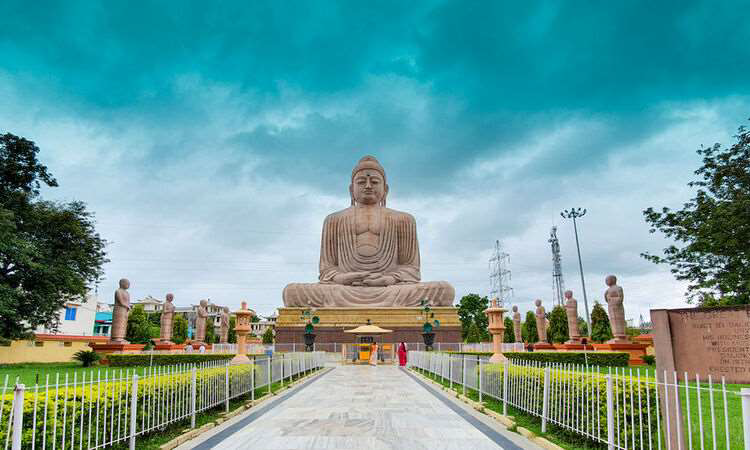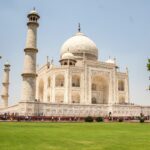India holds the roots of Buddhism. This is where Siddhartha was born, where he searched for answers, where he spoke his first words of wisdom, and where his journey ended. Traveling through the Buddhist Circuit almost feels like rewinding time and quietly walking alongside him.
What is the Buddhist Circuit?
The Buddhist Circuit is basically a route that connects the places most important in Buddha’s life.
- Lumbini – his birthplace (today in Nepal, but always linked to the story)
- Bodhgaya tour – where he sat under the Bodhi Tree and reached enlightenment.
- Sarnath Buddhist sites – where he gave his very first sermon.
- Kushinagar – where he passed into Mahaparinirvana.
Each stop has its own mood—peaceful, powerful, and deeply personal.
Places That Tell Buddha’s Story
Lumbini
This is where it all begins. At the Maya Devi Temple, standing in the gardens, it’s hard not to imagine a young prince being born here, unknowingly about to change the world.
Bodhgaya tour
For many, this is the heart of the journey. The Bodhi Tree where Buddha meditated still stands, a silent witness to his search for truth. The Mahabodhi Temple nearby is full of chanting, prayer flags, and people meditating—there’s something incredibly calming about simply sitting there for a while.
Rajgir and Nalanda
Rajgir has the hills where Buddha often stayed and taught. Just a short distance away, Nalanda’s ancient ruins are a reminder of the great learning center where seekers once gathered. Walking there feels like walking on pages of history.
Sarnath Buddhist sites
Sarnath holds a special charm—it’s the place Buddha first shared his teachings. The stupa, the old monasteries, the Ashokan Pillar… all of it gives a sense of something new beginning here centuries ago.
Shravasti
Shravasti was Buddha’s monastic home for many years. The ruins of Jetavana Monastery might look simple, but if you pause for a moment, it’s easy to picture monks gathering here to listen to him.
Kushinagar
Kushinagar has a different mood—gentle, quiet, and thoughtful. The reclining Buddha statue at the Mahaparinirvana Temple draws people from everywhere. Being here makes one reflect on endings, peace, and the cycle of life.
Ashoka Holidays and the Journey
A journey like this is not just about ticking off places; it’s about experiencing them fully. That’s why Ashoka Holidays has shaped Buddhist tour packages in a way that covers the practical side—travel, hotels, guides—while letting the trip feel personal and meaningful.
Their knowledge of each site adds context, but more importantly, their style makes the journey flow naturally. Traveling with them often feels less like “touring” and more like being guided on a shared journey.
Why This Journey Matters?
The Buddhist tour in India is more than just a pilgrimage. It connects with anyone—whether someone follows Buddhism or not—because the essence of Buddha’s story isn’t about religion as much as it is about compassion, kindness, and inner calm.
On the circuit, it’s common to see monks from Thailand, families from Japan, and travelers from Sri Lanka all coming together in one place. That feeling of shared space and shared respect is what makes the journey feel alive.
The Best Time to Travel
Most people prefer visiting between October and March. The weather is pleasant, and the evenings feel cool—perfect for walking through ruins and temple complexes. The winter festivals around this time also add a bit of color and energy to the trip.
Conclusion
The Buddhist Circuit tour India is more than just visiting temples—it’s about being part of a story that began thousands of years ago. Each stop carries something special, from the Bodhi Tree at Bodhgaya to the quiet stillness of Kushinagar. With Ashoka Holidays, the journey becomes less about sightseeing and more about feeling—feeling the presence of history, of wisdom, and of peace.
People Also Ask
What is the Buddhist Circuit in India?
It’s the travel route that connects the main places from Buddha’s life: Bodhgaya, Sarnath, Kushinagar, and Lumbini.
How many days are required for the Buddhist tour?
A complete trip usually takes 7 to 10 days, depending on how much time is spent at each site.
Which is the most important place in Buddhist Circuit India?
The Bodhgaya tour is often considered the most important stop as it’s where enlightenment happened.
What is the best time to visit the Buddhist Circuit in India?
From October to March, when the weather is comfortable and the atmosphere is pleasant.
Can foreign tourists easily travel the Buddhist Circuit?
Yes, travel is straightforward with good transport, accessible visas, and well-planned Buddhist tour packages available.






